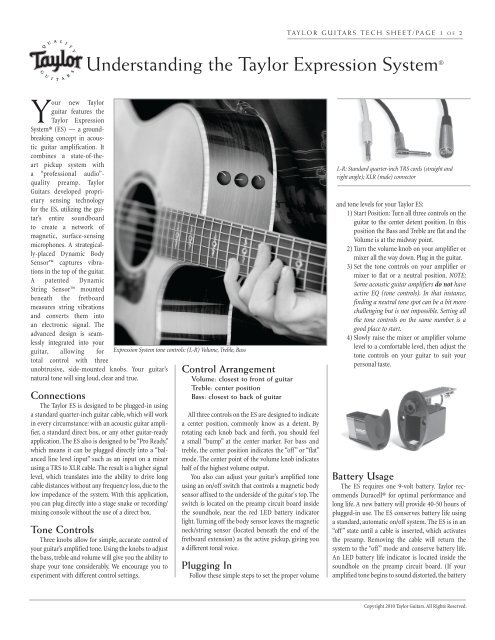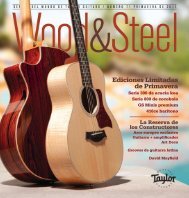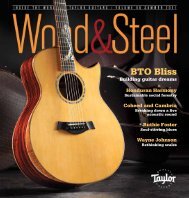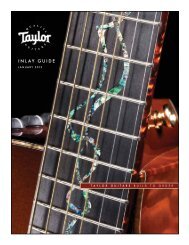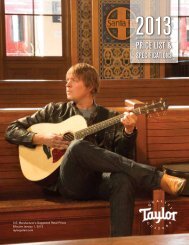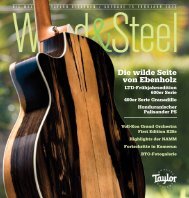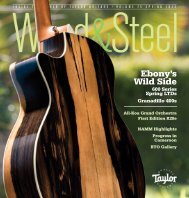Understanding the Taylor Expression System® - Taylor Guitars
Understanding the Taylor Expression System® - Taylor Guitars
Understanding the Taylor Expression System® - Taylor Guitars
You also want an ePaper? Increase the reach of your titles
YUMPU automatically turns print PDFs into web optimized ePapers that Google loves.
Y<br />
our new <strong>Taylor</strong><br />
guitar features <strong>the</strong><br />
<strong>Taylor</strong> <strong>Expression</strong><br />
TAYLOR GUITARS TECH SHEET/PAGE 1 O f 2<br />
<strong>Understanding</strong> <strong>the</strong> <strong>Taylor</strong> <strong>Expression</strong> System ®<br />
<strong>System®</strong> (ES) — a ground-<br />
Bass<br />
breaking concept in acoustic<br />
guitar amplification. It<br />
combines a state-of-<strong>the</strong>- Treble<br />
art pickup system with<br />
a “professional audio”quality<br />
preamp. <strong>Taylor</strong><br />
<strong>Guitars</strong> developed propri-<br />
Volume<br />
etary sensing technology<br />
for <strong>the</strong> ES, utilizing <strong>the</strong> guitar’s<br />
entire soundboard<br />
to create a network of<br />
magnetic, surface-sensing<br />
microphones. A strategically-placed<br />
Dynamic Body<br />
Sensor captures vibrations<br />
in <strong>the</strong> top of <strong>the</strong> guitar.<br />
A patented Dynamic<br />
String Sensor mounted<br />
beneath <strong>the</strong> fretboard<br />
measures string vibrations<br />
and converts <strong>the</strong>m into<br />
an electronic signal. The<br />
advanced design is seamlessly<br />
integrated into your<br />
guitar, allowing for <strong>Expression</strong> System tone controls: (L-R) Volume, Treble, Bass<br />
total control with three<br />
unobtrusive, side-mounted knobs. Your guitar’s<br />
natural tone will sing loud, clear and true.<br />
Connections<br />
The <strong>Taylor</strong> ES is designed to be plugged-in using<br />
a standard quarter-inch guitar cable, which will work<br />
in every circumstance: with an acoustic guitar amplifier,<br />
a standard direct box, or any o<strong>the</strong>r guitar-ready<br />
application. The ES also is designed to be “Pro Ready,”<br />
which means it can be plugged directly into a “balanced<br />
line level input” such as an input on a mixer<br />
using a TRS to XLR cable. The result is a higher signal<br />
level, which translates into <strong>the</strong> ability to drive long<br />
cable distances without any frequency loss, due to <strong>the</strong><br />
low impedance of <strong>the</strong> system. With this application,<br />
you can plug directly into a stage snake or recording/<br />
mixing console without <strong>the</strong> use of a direct box.<br />
Tone Controls<br />
Three knobs allow for simple, accurate control of<br />
your guitar’s amplified tone. Using <strong>the</strong> knobs to adjust<br />
<strong>the</strong> bass, treble and volume will give you <strong>the</strong> ability to<br />
shape your tone considerably. We encourage you to<br />
experiment with different control settings.<br />
Control Arrangement<br />
Volume: closest to front of guitar<br />
Treble: center position<br />
Bass: closest to back of guitar<br />
All three controls on <strong>the</strong> ES are designed to indicate<br />
a center position, commonly know as a detent. By<br />
rotating each knob back and forth, you should feel<br />
a small “bump” at <strong>the</strong> center marker. For bass and<br />
treble, <strong>the</strong> center position indicates <strong>the</strong> “off ” or “flat”<br />
mode. The center point of <strong>the</strong> volume knob indicates<br />
half of <strong>the</strong> highest volume output.<br />
You also can adjust your guitar's amplified tone<br />
using an on/off switch that controls a magnetic body<br />
sensor affixed to <strong>the</strong> underside of <strong>the</strong> guitar's top. The<br />
switch is located on <strong>the</strong> preamp circuit board inside<br />
<strong>the</strong> soundhole, near <strong>the</strong> red LED battery indicator<br />
light. Turning off <strong>the</strong> body sensor leaves <strong>the</strong> magnetic<br />
neck/string sensor (located beneath <strong>the</strong> end of <strong>the</strong><br />
fretboard extension) as <strong>the</strong> active pickup, giving you<br />
a different tonal voice.<br />
Plugging In<br />
Follow <strong>the</strong>se simple steps to set <strong>the</strong> proper volume<br />
L-R: Standard quarter-inch TRS cords (straight and<br />
right angle); XLR (male) connector<br />
and tone levels for your <strong>Taylor</strong> ES:<br />
1) Start Position: Turn all three controls on <strong>the</strong><br />
guitar to <strong>the</strong> center detent position. In this<br />
position <strong>the</strong> Bass and Treble are flat and <strong>the</strong><br />
Volume is at <strong>the</strong> midway point.<br />
2) Turn <strong>the</strong> volume knob on your amplifier or<br />
mixer all <strong>the</strong> way down. Plug in <strong>the</strong> guitar.<br />
3) Set <strong>the</strong> tone controls on your amplifier or<br />
mixer to flat or a neutral position. NOTE:<br />
Some acoustic guitar amplifiers do not have<br />
active EQ (tone controls). In that instance,<br />
finding a neutral tone spot can be a bit more<br />
challenging but is not impossible. Setting all<br />
<strong>the</strong> tone controls on <strong>the</strong> same number is a<br />
good place to start.<br />
4) Slowly raise <strong>the</strong> mixer or amplifier volume<br />
level to a comfortable level, <strong>the</strong>n adjust <strong>the</strong><br />
tone controls on your guitar to suit your<br />
personal taste.<br />
Battery Usage<br />
The ES requires one 9-volt battery. <strong>Taylor</strong> recommends<br />
Duracell® for optimal performance and<br />
long life. A new battery will provide 40-50 hours of<br />
plugged-in use. The ES conserves battery life using<br />
a standard, automatic on/off system. The ES is in an<br />
“off ” state until a cable is inserted, which activates<br />
<strong>the</strong> preamp. Removing <strong>the</strong> cable will return <strong>the</strong><br />
system to <strong>the</strong> “off ” mode and conserve battery life.<br />
An LED battery life indicator is located inside <strong>the</strong><br />
soundhole on <strong>the</strong> preamp circuit board. (If your<br />
amplified tone begins to sound distorted, <strong>the</strong> battery<br />
Copyright 2010 <strong>Taylor</strong> <strong>Guitars</strong>. All Rights Reserved.
UNDERSTANDING THE TAYLOR EXPRESSION SYSTEM TAYLOR GUITARS TECH SHEET/PAGE 2 O f 2<br />
Preamp Circuit Board<br />
Dynamic String Sensor<br />
(not visible)<br />
Dynamic Body Sensor<br />
Fused String Ground<br />
Input Jack and<br />
Battery Compartment<br />
most likely needs to be replaced.)<br />
To change <strong>the</strong> battery, release <strong>the</strong> clip on <strong>the</strong> battery<br />
carriage (located along <strong>the</strong> tail line) by pushing it<br />
toward <strong>the</strong> input jack. Remove <strong>the</strong> battery and replace<br />
with a new one, paying close attention to <strong>the</strong> positive/<br />
negative orientation shown inside <strong>the</strong> carriage.<br />
TIP: Batteries can leak if left unused for long periods<br />
of time. When you replace <strong>the</strong> battery, write <strong>the</strong> date on<br />
it with a permanent marker to track how long <strong>the</strong> battery<br />
has been in <strong>the</strong> guitar.<br />
Feedback Resistance<br />
The heart of <strong>the</strong> ES is a pair of proprietary magnetic<br />
pickups. A body sensor is affixed to <strong>the</strong> underside of<br />
<strong>the</strong> soundboard and can best be described a surfacemounted<br />
microphone. The ES is not, however, subject<br />
to <strong>the</strong> usual feedback problems you might encounter<br />
when playing into a microphone. The system is<br />
uniquely suited to work at high sound pressure levels<br />
(SPLs), resisting feedback even at high volume levels.<br />
If you are accustomed to using a soundhole plug to<br />
prevent feedback, it should not be necessary to use<br />
one with <strong>the</strong> ES.<br />
Tone-shaping Control<br />
The ES opens up new frontiers in sound, and will<br />
enable you to create a wide range of tones using simple<br />
adjustments of <strong>the</strong> onboard controls. The built-in<br />
equalizer reacts to subtle changes in bass, treble and<br />
volume, emphasizing individual characteristics of <strong>the</strong><br />
guitar’s natural sound.<br />
NOTE: The absence of a midrange control knob does<br />
LED Battery<br />
Life Indicator<br />
1980 Gi l l e s p i e Way • el Ca j o n , Ca 92020-1096 • 800-943-6782<br />
A body sensor on/off switch is located on <strong>the</strong> preamp circuit<br />
board and is accessible through <strong>the</strong> soundhole<br />
not mean <strong>the</strong>re is no mid-band control. It’s easy to boost<br />
or cut <strong>the</strong> mids simply by turning <strong>the</strong> Bass and Treble<br />
knobs past <strong>the</strong> center detent in ei<strong>the</strong>r direction, <strong>the</strong>n<br />
adjusting <strong>the</strong> volume. By turning both <strong>the</strong> bass and<br />
treble up, <strong>the</strong> midrange is effectively dipped; turning<br />
<strong>the</strong>m below <strong>the</strong> center detent boosts <strong>the</strong> mids.<br />
Pickup Sensor Flexibility<br />
The <strong>Taylor</strong> ES gives you <strong>the</strong> ability to voice <strong>the</strong> guitar<br />
differently for various performance applications<br />
(different types of venues, band configurations, etc.).<br />
By turning off <strong>the</strong> body sensor, you can create different<br />
voicings for different levels of sensitivity and tone.<br />
Switching off <strong>the</strong> body sensor allows you to play solely<br />
on <strong>the</strong> neck pickup if you desire.<br />
The body sensor switch is easily accessible inside<br />
<strong>the</strong> soundhole, on <strong>the</strong> edge of <strong>the</strong> preamp circuit<br />
board. When <strong>the</strong> switch is positioned toward <strong>the</strong> back<br />
of <strong>the</strong> guitar, <strong>the</strong> sensor is on. Moving it toward <strong>the</strong><br />
front of <strong>the</strong> guitar turns it off.<br />
Fused String Ground<br />
Protection<br />
The ES is equipped with a fused string ground, a<br />
patented safety feature designed to protect <strong>the</strong> player<br />
from venues or o<strong>the</strong>r amplified settings where <strong>the</strong>re<br />
may be improper electrical ground. A grounding plate<br />
affixed to <strong>the</strong> underside of <strong>the</strong> bridge plate is wired to<br />
a fuse, which removes <strong>the</strong> player from <strong>the</strong> circuit path<br />
in <strong>the</strong> event of a current seeking ground. If current is<br />
traveling through <strong>the</strong> ground, <strong>the</strong> fuse will blow, but<br />
<strong>the</strong> player will remain unharmed. The ES will continue<br />
to work, but <strong>the</strong> strings will no longer be grounded,<br />
leaving <strong>the</strong> guitar potentially more susceptible to an<br />
electrical hum. A blown fuse should be replaced by an<br />
authorized <strong>Taylor</strong> repair technician.<br />
Copyright 2010 <strong>Taylor</strong> <strong>Guitars</strong>. All Rights Reserved.


